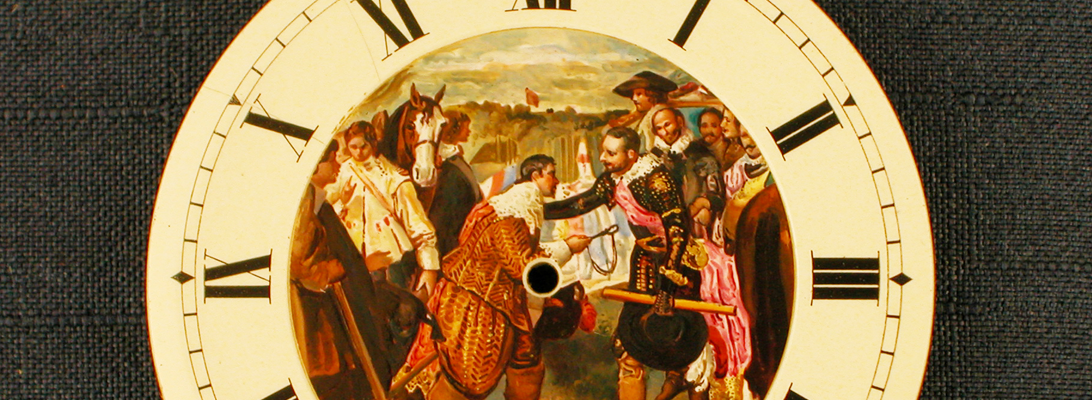Louis Ernest Reguin was born on the 29th June 1872 in La Chaux-de-Fonds, a town high in the Swiss Jura mountains. His father was en engraver and his mother a watchmaker, he was their first child. He spent most of his life here. From 1889-1895 he attended a course at the „Ecole des arts appliqués à l’industrie“ to become an engraver and enameller. According to the records of the School of Art, already at the age of 17, Louis Reguin took courses in artistic drawing, perspective, sculpture and decorative composition. From 1891-1895 he studied engraving and enamelling. The school records show that, during his studies, Louis Reguin regularly won prizes which were awarded during the school year for particular performances. In 1899 he married Milca Ducommun, a watchmaker from La Chaux-de-Fonds, the couple had 3 children. From 1903 Louis Reguin worked as a freelance artist in his workshop in the Rue du Temple Allemand 89 in La Chaux-de-Fonds. He described himself as „a painter on enamel“ and miniaturist. Painting on enamel was his main activity, indeed his livelihood. His skill was quickly recognised, which brought him orders from the most important companies. These companies included, Movado, Longines, Zenith, Doxa, Borel Fils and Weber in Geneva. Louis Reguin’s reputation also reached wealthy clients e.g. monarchs and princes. For example Louis Reguin done miniatures for the Tsar Nicolas II of Russia, a prince from the house of the Ethiopian Negus and Maharajas of India.
The enamelled pieces made by Louis Reguin are small works of art which belong to the personal, even intimate world of the owner. The admirer must examine them intensively and with tenderness, to be able to discover the worlds which glow and shine on just a few square centimetres. Our artist’s minute enamelled pieces succeed in conveying precisely the physical and psychological characteristics of personalities, the poetry of genre paintings, the greatness of massive mountain scenery and the daintiness of flower sprays.
The enamelled pieces made by Louis Reguin known up till now lead us to understand that he devoted himself most to the presentation of portraits, scenery, as well as plants and flowers. Amongst the copies of famous paintings, three enamels are of particular interest : „Jeune fille de Procida donnant à boire à un pêcheur“. This is a reproduction of a painting by Léopold-Robert from 1827. Here Louis Reguin has succeeded in reproducing the scene with the two young people on his enamel miniature much more strikingly than it is on the 86 x 74 cm oil painting by Léopold-Robert. A further enamel which is comparable to a study of the eurythmic representation of day by Ferdinand Hodler. Of particular interest is a watch dial, showing the central scene of the monumental painting „La reddition de Breda“ by the Spanish artist Velasquez : literally a „Velasquez pocket edition“.
It is on hikes and long walks in the countryside that Louis Reguin found the energy and tranquillity to accomplish his enamel miniatures with virtuosity. During these peaceful moments, surrounded by his beloved nature, most of his graphic works were realised, masterly small size works reproducing what he had experienced. He found his own personal form of expression in free drawing. Here he had no obligation to take into consideration the historical, mythical, religious, symbolic or allegorical subjects, as commissioned by his clients. He far preferred to devote his personal work to nature and scenery, still untouched to a great extent by man. His determined and rhythmical composition in the picture „Vue sur l’Eiger, le Mönch et la Jungfrau“, painted in strong, bright colours, recalls Ferdinand Hodler’s paintings of mountains, comparable to huge sculptures. In spite of the closeness to Ferdinand Hodler, Louis Reguin gives more emphasis to the atmosphere, the colour effects on the mountains and in the sky, whereas Ferdinand Hodler stresses the massiveness of a, so to speak, chiselled and sculptured figure.
It is noticeable how Louis Reguin limits his scenery pictures by framing. This is done in such a way that the admirer’s imagination is inspired to complete the non-existant scenery outside the frame. This refusal to build up a picture around a central point in a balanced way is found in the succession of the impressionists and under the influence of Japanese painting. Louis Reguin’s preference to represent fragments of the whole is shared by him with many artists of his period. The piece „Nature morte aux fruits“ is quite amazing. Here, one could almost have the impression of the quality of a Paul Cézanne, the forerunner of the modern style. As in impressionism, there are no separating lines. To the dynamic dissolution of forms, Louis Reguin opposes clearly defined sequences of strokes which systematically blend the fruit together thanks to a strong colour modulation. All elements of the picture are enclosed in a strictly organized structure, which radiates tranquillity. Each new dot of paint will be applied only when the artist is sure that it continues the harmony of the existing features. In its clear simplicity, Louis Reguin’s work reminds us of J.B.Chardin’s. The placing of the dots used by the artist for the foundation produces not only a picture of objects, it also creates a new reality, precisely once described by Kandinsky as „innerly pictorial sounding object, called picture“.
The portraits carried out by Louis Reguin, showing sensitivity, deserve no less attention e.g. the portrait of his wife, Milca, painted with affection. His flower subjects are also a direct transfer from what he has experienced. In these works he shows himself to be a botanist who knows how to combine the masterly technique of fine art with his own sensitivity, showing at the same time accurate observation.
Louis Ernest Reguin, a great man of the small size, died on the 22nd December 1948 in La Chaux-de-Fonds.
Urs Staub / Thomas Walser-Wied
